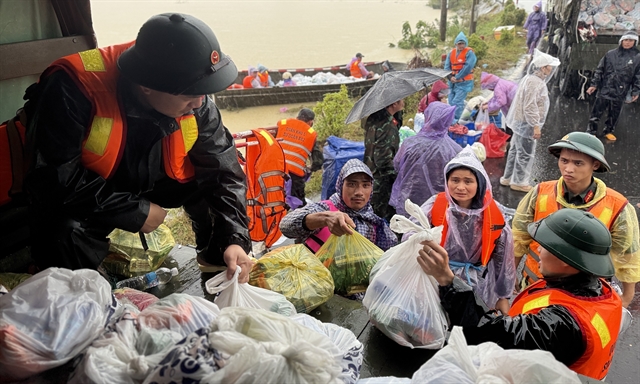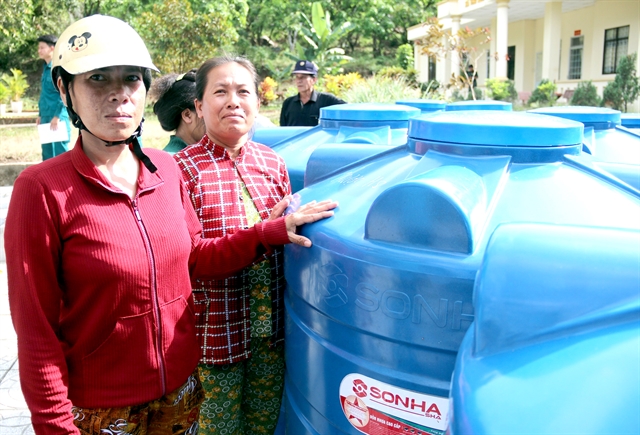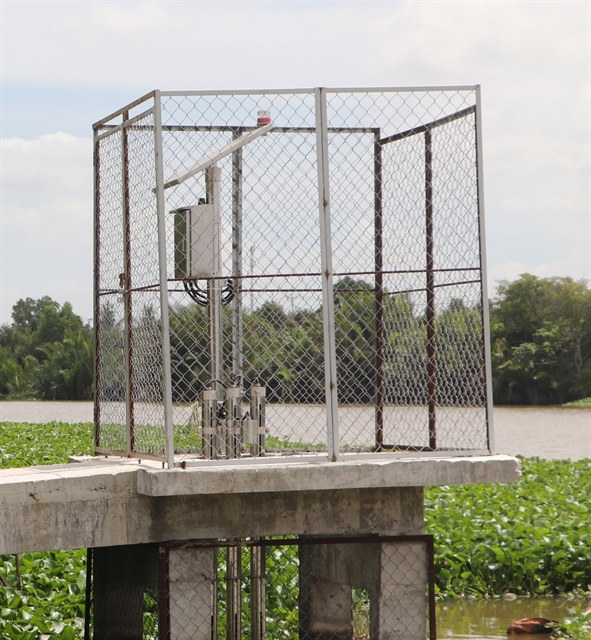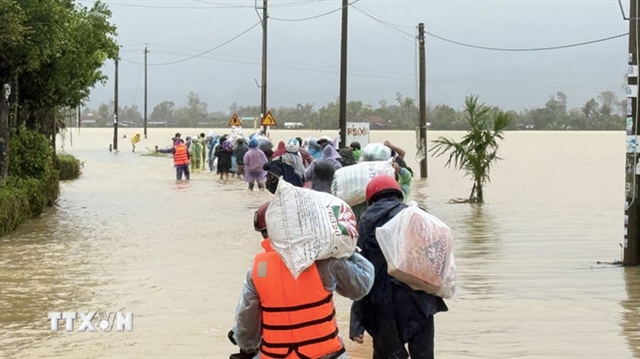 Environment
Environment

 |
| The Vàm Bà Lịch sluice and boat lock in Kiên Giang Province’s Châu Thành District is being used to regulate salinity and retain freshwater, ensuring water supply for farming and inland waterway transport during the 2024-25 dry season. — VNA/VNS Photo Lê Huy Hải |
HCM CITY — The proactive implementation of measures designed to prevent saltwater intrusion has helped alleviate the impacts of salinity in the Cửu Long (Mekong) Delta and secure water for domestic and agricultural use this dry season.
The delta, home to a population of 18 million, is the nation's pre-eminent producer of rice, fruit and seafood, and 77 per cent of its people are engaged in agricultural activities.
As the region, comprising 12 provinces and Cần Thơ City, enters the peak dry period, the ingress of saltwater is intensifying in coastal provinces such as Cà Mau, Bến Tre and Kiên Giang.
In Bến Tre, salinity with a concentration of 0.4 per cent has encroached 58.4km inland via estuaries, significantly exceeding the 0.1 per cent tolerance threshold for most crops.
Đặng Hoàng Lam, director of the Bến Tre Province Centre for Hydro-Meteorological Forecasting, said saltwater intrusion along the Hàm Luông River began early this year and has reached 51.2km inland in Châu Thành, Mỏ Cày Bắc and Bình Đại districts.
Intrusion up the Cổ Chiên River in Mỏ Cày Bắc has also extended 51km.
In Cà Mau Province, saltwater intrusion has substantially affected freshwater zones in the districts of U Minh, Trần Văn Thời and Thới Bình, Cà Mau City and nearby islands and rural areas.
As the only coastal province in the delta lacking direct access to freshwater from upstream fluvial systems, Cà Mau relies predominantly on rainwater and groundwater for both agriculture and household use.
Implementation of preventive strategies
 |
| The Kiên Giang Province Farmers Association gifts water containers to 50 poor farming households in Hòn Đất District’s Thổ Sơn Commune on April 2. — VNA/VNS Photo Lê Sen |
The delta formulated saltwater prevention strategies at the commencement of the current dry season, has been flexible with the operation of saltwater prevention sluices and conducted public awareness campaigns to promote water storage and efficient utilisation.
New saltwater prevention structures have been built, while existing ones have been repaired and upgraded.
Irrigation canals have also been dredged to store more water.
Cà Mau has developed response plans based on disaster risk levels and mobilised over 30,000 local people for natural disaster response efforts.
Lê Văn Sử, deputy chairman of its People’s Committee, has called on relevant agencies and local authorities to intensify efforts to combat saltwater intrusion across the province.
He has also requested that localities report the impacts of drought and salinity and submit relevant proposals and recommendations to ministries and agencies.
Lê Hữu Toàn, director of the Kiên Giang Province Department of Agriculture and Environment, said: “We are also increasing awareness-raising activities on climate change and sea level rise, while guiding farmers to adopt advanced water-saving irrigation techniques.
“So far there have been no reports of drought or saltwater damage in the province.”
People living across the delta have taken proactive steps ahead of the dry season to store freshwater and protect their crops.
Nguyễn Văn Thắng, who owns a two-hectare banana orchard in Kiên Giang Province’s U Minh Thượng District, said he had pumped water from the Minh Kiên Hamlet Canal into his orchard’s ponds five months ago.
“As of now water in the Minh Kiên Hamlet Canal has dropped by over 60 per cent, leaving just a little at the bottom. However, the ponds in my orchard still hold more than two metres of water, which should be enough for irrigation until the end of April.”
Cao Thị Chiên, who owns a 9,000-square-metre durian farm in Bến Tre Province’s Châu Thành District, said her orchard has not been affected by salinity thanks to early preparations.
She recalled the severe saline intrusion in 2016 and 2019 when crops were lost due to farmers lacking preventive knowledge.
“Now local farmers are much better prepared, taking steps like pruning, mulching, using organic fertilisers, dredging canals, and storing freshwater in orchard ditches.”
Trần Ngọc Tam, chairman of the Bến Tre People’s Committee, said the province has proactively implemented both structural and non-structural measures to deal with saltwater intrusion.
“Thanks to timely action from both authorities and residents, the impacts of drought and salinity have significantly reduced.”
In Bến Tre’s Chợ Lách District, the delta’s largest grower of seedlings, flowers and ornamental plants, authorities began preparing for drought and salinity since late last year.
Trần Hữu Nghị, deputy head of the district’s Bureau of Agriculture and Environment, said farmers proactively dug ponds to store water.
The district also adjusted crop schedules and advised against allowing trees to bear fruit during saline intrusion, he said.
Authorities across the delta have distributed water containers to help people store freshwater for household use.
Nguyễn Thị Mười of Kiên Giang Province’s An Biên District said: “My family was given two water containers, and we bought two more ourselves. We are storing over 4,000 litres of water for drinking and cooking. For other daily needs, we rely on wells.”
During the 2023-24 dry season, some 73,900 households in the delta suffered water shortages.
The water shortage also damaged over 1,189ha of rice.
Saltwater intrusion trend
 |
| The automatic monitoring station in Long Mỹ District’s Lương Nghĩa Commune in Hậu Giang Province provides timely updates on salinity levels. – VNA/VNS Photo Hồng Thái |
Phùng Tiến Dũng, head of the hydrological forecasting division at the National Centre for Hydro-Meteorological Forecasting, said the overall trend of saltwater intrusion in the delta is gradually decreasing this month.
“Maximum salinity levels at most monitoring stations are comparable to or lower than during the same period last year, although some stations in Trà Vinh and Bến Tre are recording higher levels.”
He said while this year’s salinity is higher than normal, it is less severe than in 2015–16 and 2019–20.
But it could increase again in late April or early May before gradually easing by mid-May, he added.
Prime Minister Phạm Minh Chính has instructed Government agencies and local authorities in the delta to take strong measures against saltwater intrusion and water shortages.
The Ministry of Agriculture and Environment has been tasked with directly overseeing and guiding coastal provinces in adopting suitable solutions.
Local authorities are required to monitor weather and hydrological forecasts closely, actively implement response plans and ensure adequate water supply for both households and agricultural production. — VNS




